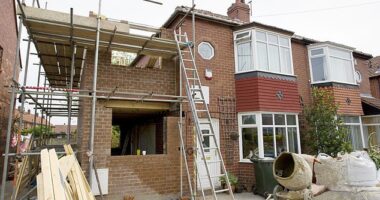HOMEBUYERS can do all the work to find their dream pad – but if issues with the property come to light the sale could be scuppered.
Trudy Woolf, sustainability director at Legal & General Surveying Services, has been trained to look at buildings to find the problems that worry mortgage lenders.
If the issue is serious enough, buyers could find their mortgage lender gets cold feet and pulls out.
But not all problems are picked up as part of the mortgage process.
Trudy told The Sun many people mistakenly think a lender’s valuation and a survey are the same thing.
However, a survey is a much more thorough search of the property by a surveyor who can see issues that most of us would not be able to spot.


Buyers can expect to pay a few hundred pounds for a full survey but going without could be a lot more costly in the long term.
“If you buy without a survey, there could be issues lurking that will come to bite you further down the line,” Trudy said.
Most of the time, issues outlined by a survey can be sorted out by talking to the seller.
In some cases, a buyer may be able to use any potential problem to haggle over the sale price, she added.
Most read in Money
Here are some of the biggest problems she sees and what they mean for a home purchase.
1. Damp
Damp is a common issue for many homes, especially older properties.
If damp is picked up during the mortgage process, lenders will want to understand the severity of the problem.
Trudy said: “It is not a huge issue but can cause minor delays to a home purchase.”
In the worst cases, a damp wall could go on to rot timber floors, so lenders will likely want to see evidence that it is being treated and under control before giving the green light.
“Buyers will need to get this information from the seller, including any documentation about when work has been carried out,” she added.
On the plus side, buyers can use damp and the cost of treatment to negotiate the purchase price.
2. Japanese knotweed
Japanese knotweed is an aggressive plant and lenders used to have almost zero tolerance if it was found near a home because of fears it would damage the property.
Lenders have now softened on this issue with the emphasis now on control rather than total eradication, Trudy said.
“It’s no more dangerous to properties than other shrubs and trees.
“But if it has been identified, lenders may ask for guarantees and warranties about how it is being managed.”
3. Big trees
Knotweed is not the only fauna that can put a spanner in the works of a mortgage application.
Trees that are tall and close to the property are a red flag because of the potential risk to damage the foundations of a property.
The height, distance and type of tree are all factors into how much of an issue it is for lenders, Trudy said.
“Tree root damage can be hugely problematic not just to the house but the drains as they seek out moisture.
“Lenders will want to know if there are visible signs of cracking or structural movement.
“It’s important to understand the property you are buying and how to manage trees.”
4. Rot
There are two types of rot that can affect properties: wet and dry.
Trudy said: “Wet rot is usually where the rainwater has got in where the property has not been maintained very well.
“It depends on the severity, but it is not usually too much of an issue for the lender.
“On the other hand, dry rot is really not good and can be a really expensive problem.
“It’s thankfully not as common, but lenders would definitely have an issue if there was dry rot on a home.”
5. Spray foam insulation
Lenders are often worried about offering a mortgage where there is spray foam insulation on the roof.
Trudy said: “It’s not a widespread problem but lenders have recently toughened their stance on homes with spray foam.
“If the work has not been carried out properly it can cause damp and condensation problems for the roof timbers which can ultimately create a lot of damage.
“Spray foam can also mean that if you have leaks coming in you won’t be able to see it.
“It’s not necessarily a no go with lenders, but there may be some hoops to jump through.”
Lenders may ask for all the relevant documentation on the works.
“They could even request spray foam to be removed before lending,” Trudy added.
“This can be an expensive and lengthy process and not something that a buyer wants to be lumbered with.”
6. Asbestos
Asbestos was a building material commonly used around the 1970s and can have major health and safety issues.
Trudy said: “It’s often seen around boilers in homes built around the 1970s.
“It can be long winded to get rid of it. A buyer should get it tested if it looks as though asbestos has been used in the house.


“A specialist will need to remove it. The biggest issue with it is that people don’t know how harmful it is.
“Asbestos is not usually an issue for lenders provided it has not been cut or drilled but some may insist it is removed before lending.”










